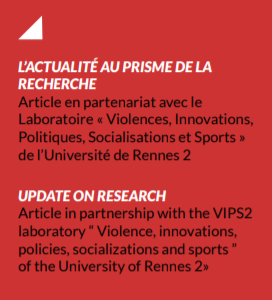Thinking about the legacy : a challenge and a necessity
Any organiser of a major sporting event nowadays is obliged to think about the legacy. But what does this mean? How to go beyond entrenched positions and analyse objectively the positive or negative impact of a sporting event on the region and the stakeholders?
 Michaël ATTALI
Michaël ATTALI
Professor, University Rennes 2
Director of the Violence, Innovation, Politics, Socialisation and Sport laboratory (VIPS2)
Discussions about sports events have been full of the expression “legacy” for several years. It is part of the vision of sport going beyond its competitive aspect and making reference to schemes run by various bodies (such as UNESCO) in the field of development and solidarity through sport. The term was often used in considering impact in economic questions, but has only more recently been used to talk about the social and cultural aspects. Since the attribution of the Paris 2024 Olympic and Paralympic Games, various stakeholders in France have used it without first engaging in an in-depth reflection on its truth, its operational perspectives, and its possible meaning.
However, researchers are studying this issue. A lot has been published in English, and several studies into the subject are being carried out by research teams such as the VIPS2 laboratory.
To go beyond entrenched positions and envisage an effective legacy, several things need to be considered. Five of these define avenues for reflection determining forms of action and directions for research.
“Mobilising outside the sport sector”
- Time-scale. The legacy should be over a minimum of 8 years. It is never spontaneous and needs to be anticipated by implementing schemes and concepts seeing the event as a catalyst for impact in several domains. In order to ensure its effectiveness and durability, the initiatives undertaken beforehand need to be pursued afterwards. Without this long-term commitment it is irrelevant to talk about legacy because the effects will be reduced or inexistent.
- In most position papers, the events will have “positive” effects. Yet there is no shortage of examples where events have had no effect or not at all the hoped-for effect. It is hard to get away from the belief in the consubstantial values of sport, which will transform those exposed to them. The idea of a “legacy” strategy is essential to identify the targeted domains and the measures needed to create the conditions for extensive change. In any case, an event cannot do everything, and should be considered in its context in order to establish appropriate objectives.
- Variety. Far from being uniform, legacy should be looked at multidimensionally. The impacts from major sporting events are multiple, so the social, cultural, psychological, sporting, symbolic, political, health and environmental aspects all need to be considered. Few events have led to any long-term increase. Questions need to be asked about the sections of society concerned, and action needs to be segmented. This also applies to aspects linked to planning and facilities, social cohesion and heritage.
- Belief in the magical effects of events often leads to action being reduced to the protagonists. This tends to isolate it from its setting and reduce its influence. Mobilisation outside the sport sector (organisers, associations, federations) is a condition of a successful legacy. Education, local authorities, social partners and all those who could use the event as an instrument for change should be considered not just as partners, but as actors in their own right.
- Evaluation, analysis, research, support. Quantitative measurement is the beginning and end of discussions about legacy. This preoccupation shows a sort of misunderstanding about what it covers and the processes that structure it. In fact, social legacy is not a finished product which can be quantified. It is developed from a multiplicity of actions whose effects need to be analysed at intermediate stages, among a wide range of people with varying viewpoints, and its effects or lack of impact in different situations need to be identified. This is less reassuring than a measurement in the strict sense of the term, but here the objective is not to sell a legacy, but to design and implement one. It therefore needs to be rigorously supported so as to create a content which, although fluid, can be envisaged if it is lucid. An evaluation might lead to the idea that the legacy is a finished product, but all the research in this area stresses that it is a process. This choice distinguishes between display and efficacy.
“Reconsider the effects of sports events so as to make them instruments for change”
To sum up, the legacy challenges how the role of sporting events is understood and conceived. For a long time, they were seen as a sign of the strength of a nation or as a setting for great exploits, and were designed to take place successfully. Very few have integrated their effect on the environment. When legacy became a factor, their legitimacy became vital.
Although some organisers are aware of their social responsibility, this is not always the case. One of the challenges of the next few years will probably be to look again at the effects of sporting events in order to make them instruments of change lasting longer than the actual event. To do this, it will be essential to include the legacy in their organisation and to follow it up, so as to give new meaning to these events. The change is surely under way, and the researchers need to be on board.








 INSCRIPTION
INSCRIPTION CONTACT
CONTACT FACEBOOK
FACEBOOK